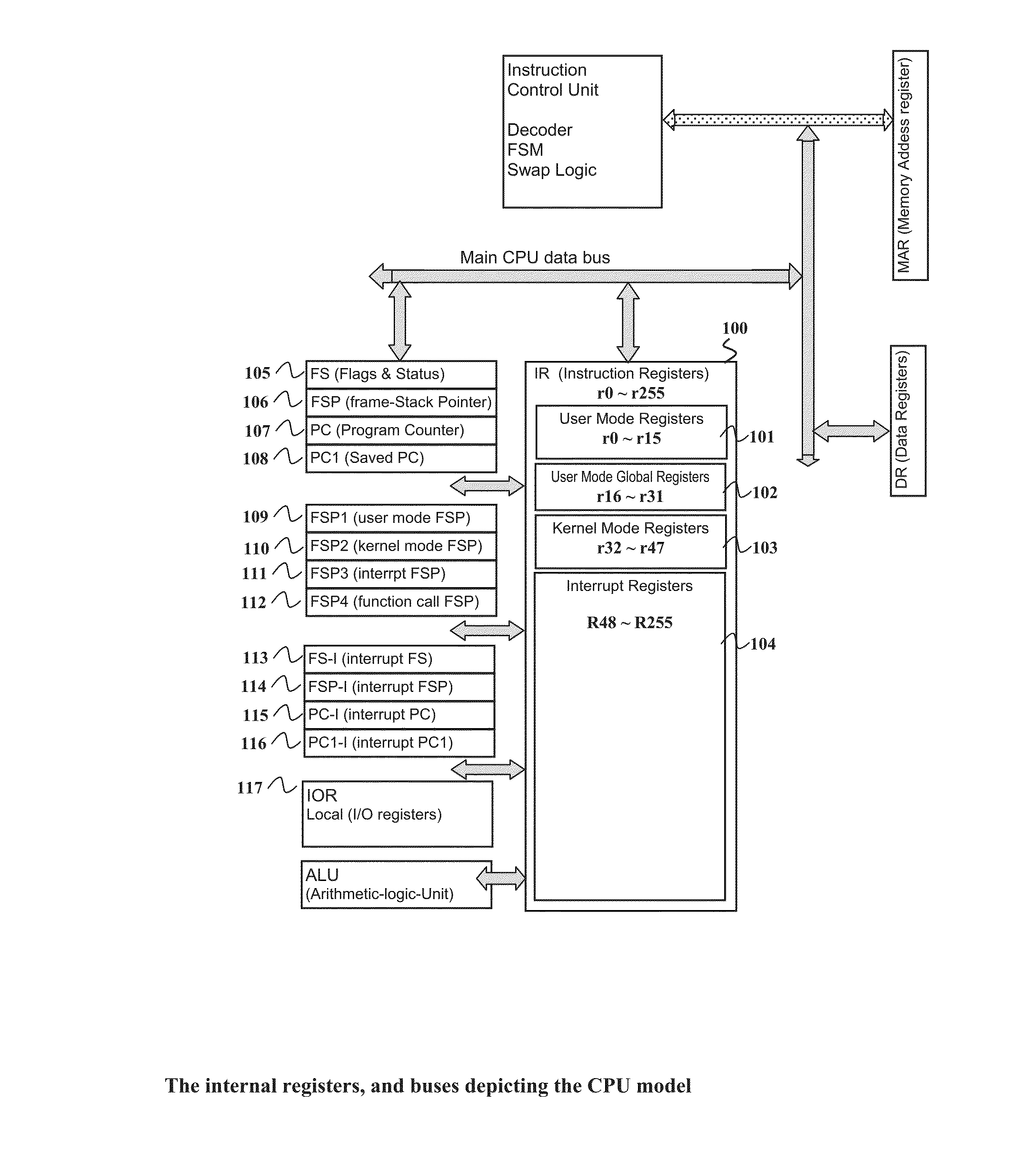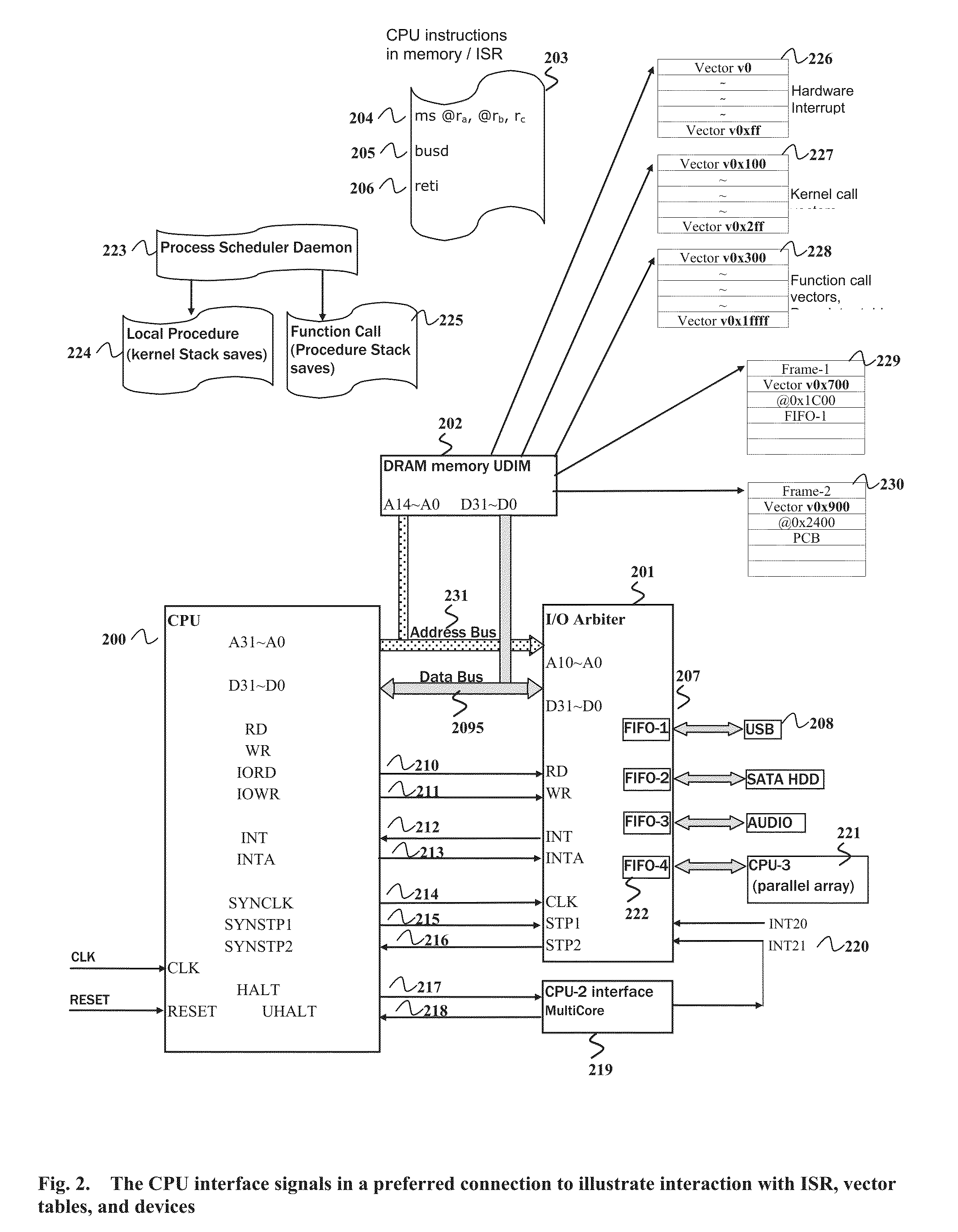Processor model using a single large linear registers, with new interfacing signals supporting fifo-base I/O ports, and interrupt-driven burst transfers eliminating dma, bridges, and external I/O bus
- Summary
- Abstract
- Description
- Claims
- Application Information
AI Technical Summary
Benefits of technology
Problems solved by technology
Method used
Image
Examples
first embodiment
[0036]In the present invention, in a typical computing process involving data transfer to an I / O device which is through its FIFO, which in this example using FIFO-1 (207); the CPU (200) in kernel mode performs a certain data operation on a block of data in memory (202). The block of data is moved into all of the CPU registers (103) for maximum efficiency, a block of the register set at a time. After completion of operation, part of the block of registers is sent to some other memory locations.
[0037]Therefore a block of data needs to be read into a memory frame. Frame-1 (229) before a set of CPU operations can begin as described earlier. This is done by an I / O port to memory read in a synchronous burst data transfer. A CPU instruction (203) reads FIFO-1 (207) using the IORD signal (210), SYNCLK (214), SYNSTP1 (215), SYNSTP2 (216) signals until FIFO-1 (207) is empty. I / O arbiter (201) then activates SYNSTP2 (216) indicating end of data, in which CPU (200) stops reading.
[0038]Similarl...
second embodiment
[0040]In the present invention, which mimics a DMA transfer, another device or another CPU; CPU-2 (219), in a multiprocessor connection wants access to the data bus, it activates the INT signal (212) by way of I / O arbiter INT21 (an example number) signal (220), in which the CPU (200) jumps to the address assigned to the vector ID of CPU-2 (219). In the ISR (203), CPU instruction busd (205) disables all buses and executes a halt instruction in which CPU (200) activates the HALT signal (217) and stops executing instructions and wait for the hardware UHALT signal (218) from CPU-2 (219). At this point CPU-2 (219) gains access to CPU address (231) and data (209) buses until it activates UHALT signal (218) in which CPU (200) returns to normal and executes next instruction typically the reti (206) in which ISR exits interrupt.
[0041]In yet another alternative of a DMA transfer, CPU-3 (221) connected via L / O arbiter (201) using FIFO-4 (222) can access a block of memory, or a memory buffer, F...
third embodiment
[0042]In the present invention, a hardware interrupt mechanism is devised to create an almost zero housekeeping instructions for a fast and efficient interrupt processing in an ISR (203). An interrupt request is activated by means of the INT signal (212) from an external source such as an I / O arbiter (201). The CPU (200) answers with an INTA signal (213) after which, the interrupting device such as a USB device (208) by way of the L / O arbiter (201) places the vector ID of the device (208) on the data bus (209). CPU (200) then reads the vector ID and makes a direct jump to the vector ID address. Vector ‘va’ denotes the vector ‘a’ which is equivalent to the ID number and can take up to 18 bits in value. The CPU (200) recognizes only 256 hardware interrupt sources as reserved in the hardware interrupt vectors memory space (226).
[0043]Before executing the first instruction in the ISR (203) corresponding to the vector ID, current main control registers consisting of the FS (105), the FSP...
PUM
 Login to View More
Login to View More Abstract
Description
Claims
Application Information
 Login to View More
Login to View More - R&D
- Intellectual Property
- Life Sciences
- Materials
- Tech Scout
- Unparalleled Data Quality
- Higher Quality Content
- 60% Fewer Hallucinations
Browse by: Latest US Patents, China's latest patents, Technical Efficacy Thesaurus, Application Domain, Technology Topic, Popular Technical Reports.
© 2025 PatSnap. All rights reserved.Legal|Privacy policy|Modern Slavery Act Transparency Statement|Sitemap|About US| Contact US: help@patsnap.com



